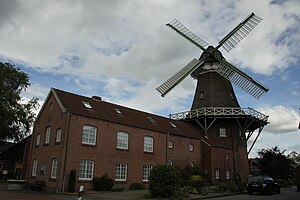Wiegboldsbur Mill
| Wiegboldsbur Mill
|
||
|---|---|---|
|
Wiegboldsbur Mill |
||
| Location and history | ||
|
|
||
| Coordinates | 53 ° 27 '22 " N , 7 ° 20' 44" E | |
| Location |
|
|
| Built | 1812 | |
| Status | functional technical monument | |
| technology | ||
| use | Flour mill | |
| drive | Windmill | |
| Windmill type | Gallery Dutch windmill | |
| Wing type | Louvre flaps | |
| Number of wings | 4th | |
| Tracking | Compass rose | |
| Website | http://www.suedbrookmerland.de/index.php?pageId=92 | |
The Wiegboldsbur mill is a listed three-storey Dutch windmill with a compass rose and louvre flaps in Südbrookmerland in Lower Saxony . The structure was erected in 1812. It is one of the landmarks of the municipality and is located in the Wiegboldsbur district .
investment
The functioning gallery Dutch windmill in the southeast of the East Frisian community Südbrookmerland now serves as a mill museum. In addition to the mill, the building ensemble includes a miller's house from 1846 with residential and farm buildings such as a barn, a packing house and a horse stable.
history
The mill was built in 1812 by Dirck Suncken Kruse as a " pelde - and grinding mill next to a house" with two grinding and peld aisles each. At the time of its construction, the structure was one storey and thus around 3.5 m lower than it is today. The canopy was initially equipped with sail wings and codend and was turned into the wind by hand. In 1851, Müller Frerich Bruns Janshen had the stone substructure and thus the mill itself increased from two to three floors, and in 1856 the miller's house was "significantly enlarged and improved" and a "carriage shed" was built. In 1909, the structure was converted from sail to louvre (flap) and wind rose operation. Around 1925 a power generation system was installed in the connecting wing of the mill to the packing house, which in addition to the mill also supplied some neighboring houses with energy. The plant could be operated with both wind and a diesel engine, which was installed in 1927 and made the mill independent of wind.
After the Second World War, only one grinder was in operation. Around 1965, damage to the walking plant, the repair of which turned out to be uneconomical, meant that the grinding operation with wind power had to be abandoned. On the initiative of the municipality, the "Mühlenverein Wiegboldsbur" was founded in 1991 and has been taking care of the building ever since. When the cap was removed, the restoration of the mill began on October 21, 1993 and was completed on November 17, 2006 as part of a festival program. In 2003, the association set up a shed to accommodate old agricultural machinery and equipment.
museum
Today there is a local history museum in the building. In the buildings there are various historical machines that document the technical development of the miller's trade and agriculture. In the storage shed belonging to the mill, a blacksmith and carpenter's workshop has been set up, in which old craft and blacksmithing is shown. Bread is baked monthly in the bakery.
See also
Individual evidence
- ↑ a b c Peter Feldkamp: The building history of the Wiegboldsbur mill. Its construction in 1812 and further development (PDF; 2.5 MB) , in: Der Mühlstein . Journal of the Association for the Preservation of Windmills and Watermills in Lower Saxony and Bremen eV , regional edition for Lower Saxony and Bremen. Issue 48 (November 2009), accessed January 16, 2012.
- ^ Municipality of Südbrookmerland: Mühle Wiegboldsbur , viewed on January 16, 2012.
- ↑ Nordwestreisemagazin: Mühle Wiegboldsbur. Everything under one roof: local history museum, bakery, handicrafts and mill , viewed on January 16, 2012.


